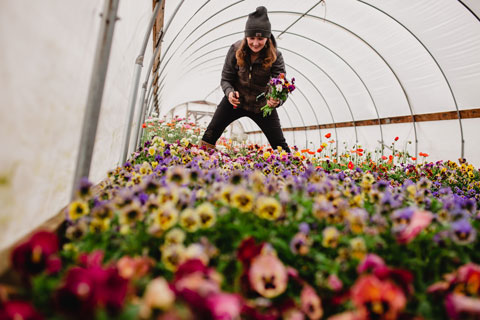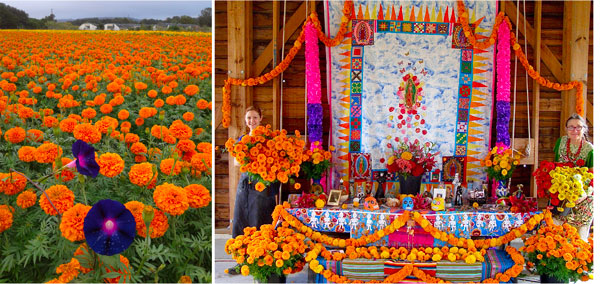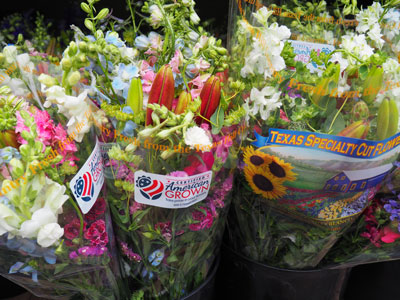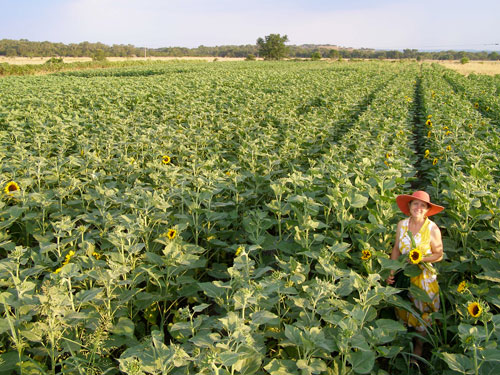11/1/2022
Cutting Your Teeth on Seed Cut Flowers
Jennifer Zurko

As with the houseplants trend a few years ago (which still continues in many parts of the country), we’re beginning to see the popularity of cut flowers rising.
No one has really been able to put their finger on why this is. There have been reports that more people bought fresh cut flowers to add a bit of cheer while they were stuck at home during the height of the pandemic or to send as gifts when they couldn’t see their loved ones for birthdays and holidays. The 2021 USDA Floriculture Crops Summary reported sales of cut flowers for the original 17 states that appeared in both the 2020 and 2021 reports rose 12.8% in 2021 over the 2020 totals. A similar comparison for cut cultivated greens showed a 17.3% increase in sales for 2021. And membership in the Association of Specialty Cut Flower Growers has increased to over 3,000 members during the last few years.
Pictured: One of the novel seed varieties that Forget Me Not Farms uses is pansies. Lindsay says they’re great for corsage work. But you have to make sure you get the varieties that have longer stems. Photo courtesy of Lindsay Daschner.
Maybe it’s becoming more of a thing after all, even if we don’t exactly know why.
But does it matter? Even if you’re the kind of person who doesn’t react to trends, you have to admit that growing cut flowers can be an enticing proposition. You have an advantage with having an established growing business. You already have the experience, the infrastructure, the customer base. Especially if you’re a small or medium-sized grower who’s dropped poinsettias and/or mums from your product offering, it could be an excellent opportunity to provide something new and different to your customers.
But growing cut flowers is not like flipping a switch—you have to do some homework first before you decide to dip your toes into the pool.
First things first
For almost 30 years, Frank and Pamela Arnosky has been growing cut flowers at their operation, Texas Specialty Cut Flowers, in Blanco, between Austin and San Antonio. They actually got their start as a bedding plant grower in 1986, but in 1993, they decided to experiment with seed cut flowers. The demand was so overwhelming that within a few years, their business transitioned to 100% cut flowers.
 In Frank’s experience, the best way for a traditional ornamentals grower to start growing cut flowers is to focus on the seed varieties instead of the other specialty types.
In Frank’s experience, the best way for a traditional ornamentals grower to start growing cut flowers is to focus on the seed varieties instead of the other specialty types.
Pictured: Texas Specialty Cut Flowers in Texas has developed a
big market for marigolds during the Día de los Muertos holiday. On the left is a field of Chedi Marigolds. On the right is the Arnosky’s ofrenda decorated with marigolds that Frank’s wife Pamela and daughter Hannah are holding. Photos courtesy of Frank Arnosky.
“The best way to get into this market is to not spend a lot of money on tubers, bulbs and woody plant material because it’s very expensive and there’s very low return,” he said. “If you’re spending 35 cents on a lily bulb, and yet you’re only going to get 60 cents back, you got a heck of a lot of investment in that. But seed-grown is the way to go to get started because you can get a lot of variety and a lot of experimentation done without a great deal of investment.”
The other thing you need to do is to look at your market and your customer base. Lindsay Daschner, owner of Forget Me Not Farms in Ottawa Lake, Michigan, and editor of our Bloom Beat newsletter, says that identifying your market is imperative before you even venture down the path.
“Are you trying to sell cut flowers at your garden center or are you trying to go to a farmers market or do you want to start a wholesale division? That dictates what the needs are,” she explained.
Forget Me Not Farms is located near the Michigan-Ohio border and is close enough to Ann Arbor and Detroit where the market isn’t so saturated that it can’t handle a large number of different operations, Lindsay said.
“I think the key is you just have to have a market for your flowers ahead of time because there’s nothing worse than having a field full of flowers that you don’t have sold,” she said. “If you’re in a small, rural community, I think that presents some challenges—how far are you wanting to tote your product to sell it? If you’re close to a metropolitan area, I don’t think competition is much of an issue.”
 Frank said that there is a market for cut flowers, you may just have to change gears in order to sell them. Your primary customer may not be “cut flower movers.” The two places Frank feels are the best cut flower opportunities are grocery stores and wholesale or retail florists.
Frank said that there is a market for cut flowers, you may just have to change gears in order to sell them. Your primary customer may not be “cut flower movers.” The two places Frank feels are the best cut flower opportunities are grocery stores and wholesale or retail florists.
Farmers markets are also a good place to sell cut flowers, but depending on your area, your local market may already have an established vendor—maybe even multiple ones.
“If there are two or three or four growers at a market, it could tend to saturate it really fast,” explained Frank.
Pictured: If you make pre-made bouquets, you can customize the sleeves with your logo or brand. Here you can see Texas Specialty Cut Flowers’ signature blue barn and the “Certified American Grown” logo. Photo courtesy of Frank Arnosky.
Dave Dowling, who’s an account rep for Ball Seed, grew cut flowers for 20 years before he started selling them for the last 10. He says that it’s not just the number of vendors you need to pay attention to, but also the clientele of the farmers market—if you got people wearing Kate Spade wellies and driving nice cars, you know they’re more likely to buy your flowers.
“You’ve got to worry about the market if you’re spending all of this time and money to sell your product,” said Dave. “If you notice that they spend money on the luxury stuff, they’re going to buy flowers.”
Frank says the real growth in our industry is in grocery stores. “That’s where the majority of flowers are sold these days and, unfortunately, most of them come from overseas. But the grocery stores are very receptive to locally grown.”
Texas Specialty Cut Flowers has a strong relationship with its grocery chain customer H-E-B, which Frank says likes to focus on Texas-grown products. They’re so supportive of this that H-E-B was one of the sponsors for his American Grown Field to Vase event this past October.
But grocery stores don’t pull any punches—if you can’t provide the product when they need it all the time, their patience will only last so long.
“It’s just like selling Coca-Cola—if Coke doesn’t show up, they’re going to put Pepsi on the shelf,” said Frank. “So our commitment to growing for the grocery store is that you do have to be in it for the long haul. I know most of the people that have been growing bedding plants understand that. In my mind, [grocery stores] are your best bet.”
The easy part
If you were a newbie to the hort biz and starting a cut flower operation, the hardest part would be figuring out your production. But Frank said those with established growing businesses already have a leg up.
“Seed-starting is the biggest challenge for most of the people trying to get into this business in the category that is known as ‘the farmer florist,’” explained Frank. “Those folks are starting seeds in a closet under grow lights using soil blocks and nobody in their right mind in the greenhouse business would ever do that. Those of us who grow plugs learned how to grow them early and we’ve got a built-in advantage, so the plant production part is the easy part.”
What you have to do next is decide which varieties you want to grow. Some common crops that Frank and Lindsay recommend are sunflowers, zinnia, celosia, salvias and gomphrena, and grasses like sorghum and millet, especially if you’re starting them in the summer. Cooler-season crops for spring to hit Mother’s Day sales that Frank calls “overwintering annuals” include snapdragons, stock, larkspur, centaurea and agrostemma.
For sunflowers, Lindsay recommends you direct-sow, either in the field if you’re growing them outside for cuts or if you’re growing them as a potted crop.
“It depends on the scale that folks are wanting to do this. If they’re wanting to plant a couple 100-ft. rows, they can put them inside a John Deere planter behind a tractor,” she explained. “Sunflowers are very easy in that sense because the seeds are so large that a lot of seeders used in traditional agriculture can pick those seeds up and direct sow.”
For every other crop, Lindsay suggests starting the seeds in plug trays. (Forget Me Not Farms uses 200s.) But it also depends on the scale you want. Frank’s operation produces 30,000 plugs a week in 128-cells.
One crop that’s been huge for Frank’s business is marigolds for Día de los Muertos in November. Being in Texas with a large Latino population helps.
“We grow tens of thousands of bunches of marigolds that go to the San Antonio warehouse and get distributed all over the state of Texas though our H-E-B stores. And it gets bigger every single year,” he said. “It’s really such a heart-felt holiday and it’s gaining a lot of momentum. With so much focus these days on cultural diversity, it has become a wonderful thing that people are focusing on.”
The hard part
You’ve got the customer. You’ve got the seeds. Now you have to train your staff how to harvest and handle cut flowers—something that’s very different from handling hanging baskets or sleeving poinsettias. Adding cut flowers to your product offering is a good way to keep your staff busy year-round, but it does take a different skill set.
“With sunflowers, you have to hand-cut every stem, strip the leaves off and then band it, so there are a couple extra steps,” Lindsay said. “At the end of the day, the cost for that stem should counteract the additional labor.”
And the mindset also is different. With bedding plants, you want them in full color; with cut flowers, you want to harvest them right when they’re just starting to open.
“You want to catch things before they’re primed, so that way, when you send it out to the consumer, they get the most life out of it,” said Lindsay. “With cut flowers, you’re dealing with a very time-sensitive commodity, so the better experience that the end consumer gets with your flowers, the more likely they are to come back.”
“It's going to be hard to train your crew to go back and forth, but it’s not impossible. Labor is so hard anyways,” said Frank.
Bedding plant growers in northern states can dovetail cut flowers right after spring annuals, growing in June/July to September in the field. “So it does give you the option of keeping your staff busy those months even if you do poinsettias,” Frank said.
 But harvesting cut flowers is a science, Frank said, and you need to understand the science.
But harvesting cut flowers is a science, Frank said, and you need to understand the science.
“Basically, you’re trying to cut a flower and make it still live as if it were on the plant,” he explained. “You’ve got to learn what you’re doing with each flower and each flower has its own different requirements.”
So doing some homework on how to properly harvest cut flowers is essential. A good resource is “Postharvest Handling of Cut Flowers and Greens” written by John Dole of North Carolina State University and other researchers in 2017. (You can order it at ascfg.org/shop/books.)
Pictured: A field of Dorit Sunflowers (with Pamela Arnosky in the foreground) at Texas Specialty Cut Flowers. These sunflowers were planted for a Fourth of July special to their grocery store customers. Photo courtesy of Frank Arnosky.
Frank also recommends a book from 1922 called “Fritz Bahr’s Commercial Floriculture: A Practical Manual for the Retail Grower.” (You can still get it on Amazon or from used book sellers.) He says Mr. Bahr is “one of the overlooked masters of horticulture. I found it in a used book store and felt like I discovered the Dead Sea Scrolls.”
“You want to keep your help—that would be the best motivator for doing this. But there is more work on the back end and having to move a product readily,” said Lindsay. “I think people should really do some soul-searching and decide if this is a trick that they want to learn. But it's incredibly meaningful. It gives a lot of people joy.
“We wouldn’t be working this hard if we didn’t value what cut flowers do for people. I think once people start seeing how much of an impact that makes, the answer will be really simple.”
Other advice from Lindsay and Frank:
• Most of the suppliers you buy your bedding plant seed from also sell seed cut flowers. “Talk to your sales rep and ask them what their company is offering for cuts and get all the advice you can,” said Frank.
• Start off with small, controlled trials and see what works. “Try a little of everything and see what works,” suggested Frank. “We did kind of a shotgun approach when we first started out and we winnowed it down to a few things. Look at what grows in your area. If it doesn’t work after three tries, let go of it.”
• If you’re growing outside, treat them like a vegetable crop. “I read a lot of information about vegetable production because growing cut flowers in the field is really the same process as growing vegetables in the field,” said Frank.
• The biggest challenge with outdoor growing is controlling weeds. You’re already used to this if you grow mums or shrubs.
• “A mistake that people make is that cut flowers have to be succession-planted. So if someone wants to add cut flowers into their rotation they have to commit to doing multiple sowings because there’s nothing worse than finding out there’s actually a demand for this and then it ends up being a flash in the pan. And then after three or four weeks, you don’t have any more product to sell,” said Lindsay. “If people are wanting to experiment with cut flowers, it’s worth doing multiple successions, just to give it a fair shake.”
• Cold frames/hoophouses are great for growing cut flowers, especially if you’re in the north and want to start sowing earlier. “You can actually get flowers by the third week of May at the latest around here [in Michigan],” said Lindsay. “Basically, you get an extra six weeks of harvest. And it doesn’t have to be very elaborate; it doesn’t even have to have heat in it.”
• Make sure you have a cooler to hold the harvested flowers and sanitize often. “If you have a bulb cooler, you’re going to want to make sure you do some disinfecting before you convert that to flowers because you don’t want Botrytis and mildews in there that can discolor the petals,” said Lindsay.
“Just like you’re harvesting produce or any kind of food product, you have to keep them in a cold chain and a clean environment,” said Frank. “We go through thousands of buckets here and we reuse a lot of them. They’re washed with a double wash with soap and then Clorox where they’re literally clean enough to eat off of. That’s the only way you’re going to keep these flowers from going downhill.”
• Keep your holding water clean, too. “The reason cut flowers die mostly is because of bacteria; not because of age or lack of water,” said Frank. “When bacteria grows in the water, it blocks the stem. We use a cut flower preservative that has a bactericide or a chlorine-based biocide, a sugar for food for the flower, then it also has some kind of pH buffer to bring the pH down, something like citric acid. That’s what keeps them clean and fed. [That’s pretty much what’s in those packets that come with bouquets.] You want to lower your pH because water goes up the stem easier when the pH is lower.”
• “Another concept that people getting into field-grown cut flowers need to know about is a hydration system,” said Frank. “The flowers that are in the sun and in the wind, of course, tend to wilt very fast, so we use a hydrating solution when we cut and that is key. That allows us to cut long stems like delphiniums and larkspur, and keep them well-hydrated in the field before we get them into the packing area.”
Frank said that it’s basically a surfactant that consists of a soap-like material that allows the water to go up the stem much faster.
“If you’re growing a beautiful flower and then you’re not treating it correctly, you won’t get good returns because people will be disappointed that they didn’t last.”
• Growing directly in the ground comes with its own set of challenges. “It’s a long-term substrate, so you don’t want to be building calcium and alkalinity in your soil as a result of using just your well water,” said Lindsay. “There are still considerations with plant nutrition even though you’re growing in soil, but it has inherent chemical properties where you probably don’t need to do constant liquid feed like you do with a hanging basket.”
• Figure out if you need a certain “presentation” at retail—do your customers want them to come in sleeves or just in bunches? You can customize sleeves to include your logo, but keep in mind that pre-made bouquets will take extra labor.
According to the Society of American Florists, 80% of specialty cut flowers are grown off-shore. Dave Dowling thinks this could change in the future.
People still want to buy locally produced goods, especially “when they can see the farm,” said Dave. “Whether that means going to pick your own [at a U-Pick farm] or seeing the grower at the farmers market or going to Whole Foods and seeing the name of the business on there. They know it’s a local product and they want to buy it. There’s that personal connection between the farm and the customer when you can sell directly to them.”
And production overseas was significantly disrupted during the last few years because of COVID and civil unrest in countries that produce cut flowers, like Ecuador, when shipments just stopped.
“I’ve always felt that there’s room enough for lots more cut flower growers in the U.S.,” he said. “More people are buying flowers and buying them more often. You don’t necessarily have to take away business from the importers; just increase sales overall. And everybody’s sales go up.”
“Really, 100% of what you grow can be grown in Colombia cheaper and almost better. I hate to say that, but they do a really good job,” said Frank Arnosky. “If I just come into the market with ranunculus that’s already coming out of Colombia, they’re going to be better priced and good quality. So I need to come in with a local ranunculus or something that has an identity. To compete in the specialty cut flower business, you gotta really market the farm itself.” GT